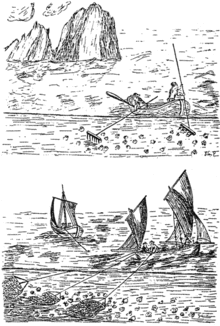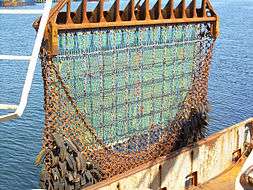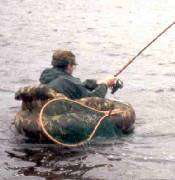Fishing dredge
A fishing dredge, also known as a scallop dredge or oyster dredge, is a kind of dredge which is towed along the bottom of the sea by a fishing boat in order to collect a targeted edible bottom-dwelling species. The gear is used to fish for scallops, oysters and other species of clams, crabs, and sea cucumber.[1] The dredge is then winched up into the boat and emptied. Dredges are also used in connection with the work of the naturalist in marine biology, notably on the Challenger Expedition.
Construction
The dredge is usually constructed from a heavy steel frame in the form of a scoop. The frame is covered with chain mesh which is open on the front side, which is towed. The chain mesh functions as a net.
Dredges may or may not have teeth along the bottom bar of the frame. In Europe, early dredges had teeth, called tynes, at the bottom. These teeth raked or ploughed the sand and mud, digging up buried clams. This design was improved by using spring-loaded teeth that reduced bottom snagging, and so could be used over rough ground.[1] The New Bedford (USA) dredge does not have teeth.
Dredge nets have a coarse mesh in order to let organisms smaller than the target species through. The net catches the larger organisms: in the case of scallop dredging that includes the scallops' predators, such as whelks, starfish and octopus.
In some cases several dredges are attached to a wheeled rigid axle in groups of three or four. A number of these dredges can be towed from a heavy spreading bar, usually one from each side of the vessel. The length of the bar and number of dredges towed depends on the power of the vessel and the room on the side deck for working the dredges. The number might be three on each side on a small 10-metre (33 ft) boat up to 20 on each side for a 30-metre (98 ft) vessel with 1500 hp.[2] The great weight and strength of the gear can disturb the ground it is towed over, overturning rocks and dislodging and crushing organisms in its path.[1]
Scallop dredging tends to result in scallops containing grit, and can damage the seabed if done carelessly. So these days scallop dredging is often replaced by scuba diving.[3] Like a better mouse trap, there is still a challenge for inventors to produce a kinder and more gentle scallop dredge.[4]
Gallery
 Mussel dredgers
Mussel dredgers
 Vessels dredging for oysters, c. 1875
Vessels dredging for oysters, c. 1875 Oyster boats of the Truro Oyster Fleet. This fishery is the last in the world to work by sail alone
Oyster boats of the Truro Oyster Fleet. This fishery is the last in the world to work by sail alone Oyster dredge at work, c.1875
Oyster dredge at work, c.1875 Oyster Boats North River, by John Henry Twachtman (1853–1902)
Oyster Boats North River, by John Henry Twachtman (1853–1902) Oyster Sloop, Cos Cob, by Childe Hassam (c.1902)
Oyster Sloop, Cos Cob, by Childe Hassam (c.1902) Dredging For Oysters, by Alexander Rummler. WPA mural.
Dredging For Oysters, by Alexander Rummler. WPA mural. Oyster harvesting using rakes (top) and sail driven dredges (bottom). From L'Encyclopédie of 1771
Oyster harvesting using rakes (top) and sail driven dredges (bottom). From L'Encyclopédie of 1771
See also
- Bottom trawling
- Gathering scallops
- Gathering seafood by hand
- Marine biology dredge
- Oyster boats
- Solway Harvester
Notes
- 1 2 3 Moore G., Jennings S. & Croxall J. (2000) Commercial Fishing: The Wider Ecological Impacts. British Ecological Society. ISBN 0-632-05608-8. Page 14
- ↑ Dredges seafood.org. Retrieved 11 February 2009.
- ↑ Walker, Margaret (1991). "What price Tasmanian scallops? A report of morbidity and mortality associated with the scallop diving season in Tasmania 1990.". South Pacific Underwater Medicine Society Journal. 21 (1). Retrieved 2013-07-16.
- ↑ MIT (2007) Kinder, gentler scallop dredge invented. Retrieved April 13, 2008.
References
| Wikimedia Commons has media related to Shell dredging ships. |
- National Research Council (US) (2002) Effects of Trawling and Dredging on Seafloor Habitat. Committee on Ecosystem Effects of Fishing. ISBN 0-309-08340-0
- Hall-Spencer & Moore PG (2000) Scallop dredging has profound, long-term impacts on maerl beds. ICES Journal of Marine Science. 57, 1407-1415.
External links
| Look up fishing dredge in Wiktionary, the free dictionary. |
| Wikisource has original text related to this article: |



